

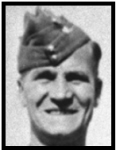

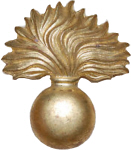
H/6008, Company Sergeant Major, John Robert OSBORN V.C.
Aged 42

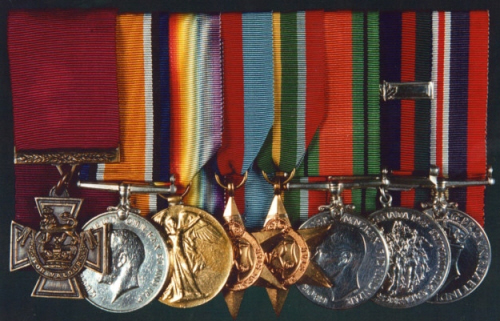
They are:-
Victoria Cross-British War Medal-Victory Medal-1939-45 Star-Pacific Star-Defence Medal-Canadian Volunteer Service Medal with clasp for overseas service and the War Medal 1939-45.
Since this photograph was taken the Hong Kong Bar, issued in 1992, has been acquired and added to the CVSM. (CWM Photo)
|
John Robert OSBORN was born on 2nd January 1899 in Foulden, Norfolk (about 5 miles SW of Swaffham) (Swaffham Q1-1899 4B:350), son of John Robert and Harriet Susanna OSBORN (née TOMLIN).
1901 census..Aged 2, he was at the Caravan, Lion Inn Yard, near Side Gate Lane, Hackford, Forehoe, Norfolk, with his father John [31] a hawker, born West Wickham; his mother Harriet [32] born Essex; brothers Harold [5] and Theodore [4]; sister Alice [1month]. All the children were born in Foulden. 1911 census..John is not yet found in this census. His parents were back at Foulden, in Burton's Yard, Hythe Road. Father was a travelling showman. John junior's brtoher Harold [15] born Clactonon Sea was visiting. Also there were his brothers Theodore [14] and Thomas[7] and sister Alice Hester [7] all Foulden born. The extent of their stay in Balsham is not known, his father died there in 1934. There is much information about him on the internet but below is an article from Tony Beeton (whose family long lived in Balsham) |
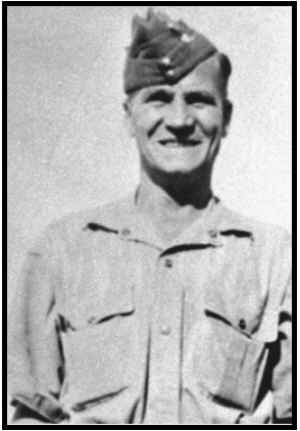

|
with permission from Tony Beeton:- Warrant Officer Class III Company Sergeant Major John Robert (Jack) Osborn VC CSM Winnipeg Grenadiers, R.C.I.C. Killed in action on Friday 19th December 1941 aged 42. His Citation appeared in London Gazette 1st April 1946. His name is inscribed on the Sai Wan Memorial, Hong Kong. His name is inscribed also on the Balsham War Memorial, Cambridgeshire. He was born in a caravan on 2nd January 1898, in or near Foulden a small village just north of Thetford, Norfolk. The family have been described as travellers or gypsies making and selling pegs, rock confectionery and working on seasonal crops on various farms throughout Norfolk. The 1901 Census has the family caravan parked at the Lion Inn yard in Hackford, Norfolk, His father John, who had been born in 1870 at West Wickham in Cambridgeshire, described himself as a fruiterer and was working on a local farm. John's mother was Harriet Osborn born in Essex in 1869. There were three sons and one daughter, Harold aged 6, Theodore aged 4, John aged 2 and Alice aged just 1 month. At some stage they moved to Balsham where other members of the family had settled. They lived in Old House Road at Balsham. John was employed as a groom. Prior to the First World War John had joined the Army Reserve but when he reached 18 he was conscripted or volunteered for the Royal Navy on 30th December 1916 and joined the Royal Naval Division (RND) 'A' Reserve Battalion at Blandford Camp in Dorset. His Naval Record Card shows he was enrolled into the R.N.D on 9th March 1917. He was described as being 5ft 3 inches (161.3 cm)tall, fresh complexion, blue eyes with light brown hair. After training he was assessed as an Able Seaman on 19th October 1917 and attached to the 2nd Reserve Battalion of the Royal Naval Division Reserve at Blandford. John was drafted into Hawke Battalion on 11th February 1918 and was shipped to Calais on the 15th. From here he joined his Battalion and on or about the 26th March he was gassed and was assessed as wounded severely and his next of kin were informed on 27 March 1918. He was sent initially to the General Hospital at Rouen and on the 31st March he was invalided out to the Western General Hospital in Manchester. On the 20 July 1918 he was assessed as a casualty Class II and allowed leave and it seems he returned to Balsham, but his condition was such that he was admitted to the 1st Eastern General Hospital whose HQ was Trinity College, Cambridge with annexe's in the College grounds, Leys School and three wards in what was to become the old Addenbrookes Hospital. By the 10th October he was sufficiently recovered to be given leave from the 3rd to 10th October and was transferred to the 2nd Reserve Battalion at Aldershot. On the 17th April 1919 he was demobilised at Harrowby Camp, Grantham and placed on 28 days demobilisation leave, his date of discharge being 15th May 1919 for which he had to attend the Thetford Dispersal Station. He was paid off in the sum of £11.10 shillings. It would appear John's injuries continued to cause health problems. The local village doctor suggested living in a better climate might prove helpful. John moved to Canada in 1920, and farmed for two years at Wapella, Saskatoon, and then worked for the maintenance division of the Canadian rail road in Manitoba. He returned to farming and in 1933 joined the Winnipeg Grenadiers Reserve. Six years later he was called to active duty. By the Second World War he was a Company Sergeant Major in 'A' Company, Winnipeg Grenadiers who found themselves on 27th October 1941 sailing from Vancouver to Hong Kong. He was a very able and respected senior NCO and looked after his men. In the fighting near Mt Butler, Hong Kong he was killed. After the war John's actions were brought to the attention of the military authorities and the King awarded him the Victoria Cross, four years after his death. He had become the second oldest recipient of the award in World War Two. A statue of soldier has been erected in Hong Kong Park and a commemorative plaque has been placed alongside dedicated to CSM Osborn VC. The statute is not of John Osborn but is a statute of a WW1 soldier. It's origins are worthy of mention and I am grateful to Tony Banham author of 'Not the Slightest Chance' which tells the story of the battle at Hong Kong in WW2 for this information. The statue was built for Eu Ten Song and placed pre-war at his famous villa at Repulse Bay (Eucliffe). This became the scene of a massacre of British and Canadian soldiers during the fighting in WW2. The statue was transferred to its current location post-war and married to an inscription about John Osborn. It had previously been sited in Osborn Barracks in Kowloon. The plaque accompanying the statute states;- "Erected here in memory of WOII John Robert Osborn VC, Winnipeg Grenadiers, and through him all those men and women, service and civilian, and of every race, colour and creed, whose secret acts of gallantry and self-sacrifice in the defence of Hong Kong, December 1941, went unnoticed and unrecorded". The old Barracks were renamed Osborn Barracks in his honour after the War which many post war Servicemen serving in Hong Kong may remember. A wing of the Deer Lodge Centre Hospital in Winnipeg was dedicated on 19th December 1991, the 50th Anniversary of John's award. Deer Lodge was re-dedicated as the John Osborn VC Tower in his honour and a bronze plaque unveiled. The Hospital was first established as a military convalescent home in 1916 for returning war veterans. On 19th December 2001 a marble memorial was unveiled by the Hong Kong Veterans Community Association in the entrance to the Tower Hospital. At the same time two plagues were unveiled, one in memory of the Winnipeg Grenadiers and the second to John Osborn at Jardine's Point near to where he lost his life. Additional item from the Canadian Legion Magazine on the web dated 2001 re the return of veterans to Hong Kong goes on to say:- The final business in Hong Kong was the unveiling of a plaque on Mount Butler in honour of the Winnipeg Grenadiers and Company Sergeant Major John Osborn who was posthumously awarded the Victoria Cross for his actions. The plaque was unveiled at Jardine's Lookout which is now a popular recreation and barbecue area. It was near that spot that 'A' Company of the Grenadiers engaged the enemy and took the summit for three hours. When other units began to withdraw from the mountain, Osborn ordered the troops to give them covering fire. He remained calm, constantly moving among the men offering encouragement. On a number of occasions he picked up incoming grenades and threw them back at the enemy. Finally, as he was talking to a sergeant, one fell near them. Osborn pushed the sergeant--knocking him down the hill--and threw himself on top of the grenade saving the sergeant and at least six other men. In March of 2005 John Robert Osborn VC was installed by the Legion into the Canadian Hall of Valour. His medals are held in the Canadian War Museum, Ottawa. Researched by Tony Beeton 2009 and is his copyright. Another detailed account of his life and exploits can be found here - www.scholars.wlu.ca/cgi/viewcontent.cgi?article=1057&context=cmh Not much use trying to add to that, the bit about serving aboard ship at the Battle of Jutland is just legend, his Navy records show no such service, just the Naval Division. The citation for his V.C. is here:- At Hong Kong on the morning of 19th December 1941 a Company of the Winnipeg Grenadiers to which Company Sergeant-Major Osborn belonged became divided during an attack on Mount Butler, a hill rising steeply above sea level. A part of the Company led by Company Sergeant-Major Osborn captured the hill at the point of the bayonet and held it for three hours when, owing to the superior numbers of the enemy and to fire from an unprotected flank, the position became untenable. Company Sergeant-Major Osborn and a small group covered the withdrawal and when their turn came to fall back, Osborn single-handed engaged the enemy while the remainder successfully rejoined the Company. Company Sergeant-Major Osborn had to run the gauntlet of heavy rifle and machine gun fire. With no consideration for his own safety he assisted and directed stragglers to the new Company position exposing himself to heavy enemy fire to cover their retirement. Whenever danger threatened he was there to encourage his men. During the afternoon the Company was cut off from the Battalion and completely surrounded by the enemy who were able to approach to within grenade throwing distance of the slight depression which the Company was holding. Several enemy grenades were thrown which Company Sergeant-Major Osborn picked up and threw back. The enemy threw a grenade which landed in a position where it was impossible to pick it up and return it in time. Shouting a warning to his comrades this gallant Warrant Officer threw himself on the grenade which exploded killing him instantly. His self-sacrifice undoubtedly saved the lives of many others. Company Sergeant-Major Osborn was an inspiring example to all throughout the defence which he assisted so magnificently in maintaining against an overwhelming enemy force for over eight and a half hours and in his death he displayed the highest quality of heroism and self-sacrifice. London Gazette 29th March 1946
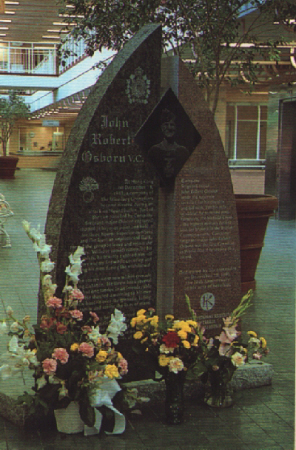 memorial at Tower Hospital...........and plaque 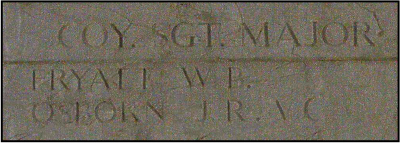 photo from asiawargraves.com photo: Commonwealth War Graves Commission click here to go to the Commonwealth War Graves Commission website for full cemetery/memorial details |